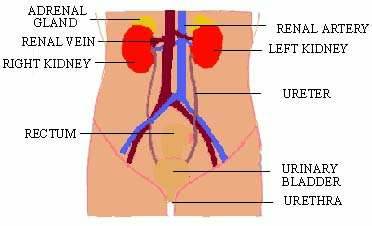|
PinkMonkey Online Study Guide-Biology
19.2 Human Excretory System
(A) Morphology: The two kidneys are compact,
red brown oval or bean shaped structures located on the dorsal wall of
the abdominal cavity (Figure 19.1). The right kidney is slightly lower
(half an inch)than the left and about four inches in length and weighs
about four ounces. Each kidney has an outer convex surface and shows an
indentation on the inner side called the hylum. The hylum functions
as a route of entry and exit for the blood vessels, lymph vessels, nerves
and ureters of the kidney. The renal artery branching from the
aorta brings oxygenated blood to the kidneys and the renal vein takes
deoxygenated blood away to the vena cava. A tube, the ureter, conveys
urine from each kidney into the urinary bladder, which opens
into the urethra. In females, the urethra opens in front of the
vagina. In males, the urethra passes through the penis and transports
both urine and semen. Each kidney is covered by a semi-liquid fatty tissue,
the adipose capsule, and this in turn, is surrounded by fibrous
connective tissue called the renal fascia. The paired adrenal glands
are present on top of the kidneys.

Figure 19.1 Excretory system of a human female
i) The Ureter. The ureter is about ten inches long, and opens by a lateral angle into the urinary bladder.
ii) The Urinary Bladder. It is hollow extensible reservoir
of urine, and changes it size and shape according to its contents. It
is situated behind the pubic symphysis in males, and in front of the uterus
in the female. It has an average capacity of seven ounces and a maximum
capacity of ten ounces.
iii) Micturition. When
the bladder is full (about 600 cm3),
waves of contraction pass down the bladder resulting in an urge to urinate.
Nerve impulses relax the sphincter muscle at the mouth of bladder, and
allow the urine to escape through the urethra. This expulsion of urine
from the urinary bladder is called micturition. When urine is expelled,
the sphincter muscles contract, the muscles of bladder relax and the urine
is collected again in the bladder. In babies (two years old and younger)
the contraction of the bladder and relaxation of the sphincter muscles
are under reflex control only. But later (after two years of age)
the reaction is usually under voluntary control.
[next page]
|
Table of Contents
19.0 -
Introduction
19.1 -
Ammonotelism, Ureotelism and Uricotelism
19.2 -
Excretory System of Man
19.3 -
Skin and Lungs as Accessory Excretory Organs
Chapter
20
|